19世纪末,第一部具有科幻色彩的影片《机器屠夫》横空出世,从此拉开了科幻电影的帷幕。这一独特的艺术形式披着“幻想”的绚丽外衣,打着“科学”的闪亮旗号,带给观众一种前所未有的观影体验。科幻电影的制作者们也的确将人类的想象力发挥到了极致,用种种高科技手段天马行空般地描述着未来世界的样子。然而,想象是绚烂多姿的,科学却是求真务实的,当亦真亦幻的科幻电影遭遇脚踏实地的科学精神,到底是会开出皆大欢喜的奇葩?还是会闹出贻笑大方的笑话?且让我们一一盘点……
Bad Science: The Core《地心抢险记》
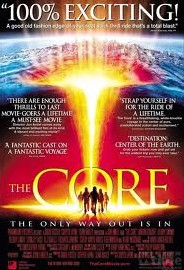 For unexplained reasons, Earth’s core has stopped spinning, causing our planet’s protective magnetic field to collapse. The movie almost gets this one right—Earth’s magnetosphere7) does protect us from blasts of subatomic particles8) from the sun.
For unexplained reasons, Earth’s core has stopped spinning, causing our planet’s protective magnetic field to collapse. The movie almost gets this one right—Earth’s magnetosphere7) does protect us from blasts of subatomic particles8) from the sun.
But for some reason the writers chose to say that it protects us from deadly solar microwave radiation. They even show a beam of microwaves cooking the ocean and destroying the Golden Gate Bridge9).
Two problems: The sun is a very weak emitter of microwaves, and worse, microwaves are not affected by magnetic fields! The feeble10) glow of microwaves from the sun is absorbed by our air on the way down, anyway, so unless the core somehow also strips off11) Earth’s atmosphere—in which case we have bigger problems than solar radiation—we should be safe enough from microwaves if our planet’s center stops spinning. Which it can’t.
地核不知何故停止了转动,导致保护地球的磁场随之消失。关于这一点,本片的理解几乎是正确的——地球磁层的确可以保护我们免受太阳喷射出的亚原子颗粒流(编者注:即太阳风)的攻击。
但是不知道什么原因,作者却另辟蹊径,说什么磁层保护我们免受的是致命的太阳微波辐射。他们甚至还展示了微波光束煮沸海洋和摧毁金门大桥的场景。
这里存在两个问题:太阳的微波辐射强度极弱;更关键的是,微波根本不会受到磁场的影响!其实不管怎样,微弱的太阳微波在下行的过程中是被大气吸收了的,因此,除非地核还能莫名其妙地除掉地球的大气层——真要如此,我们面临的问题可比太阳辐射严峻得多了——否则,即便这个星球的中心停止转动,我们也应该不会受到微波的危害。而地心是不会停止转动的。
Bad Star Wars: Episode II—Attack of the Clones
《星战前传II——克隆人的进攻》
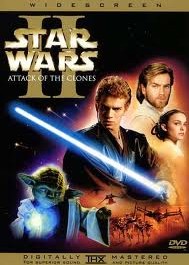 In this continuation of the Star Wars saga, our hero, Obi-Wan Kenobi, is chasing bad guy Jango Fett, who tries to escape in the thick rings of the planet Geonosis12). Fett deploys “seismic13) charges14)” to kill Kenobi. When the charges explode, they send out huge shock waves that nearly shake Kenobi apart.
In this continuation of the Star Wars saga, our hero, Obi-Wan Kenobi, is chasing bad guy Jango Fett, who tries to escape in the thick rings of the planet Geonosis12). Fett deploys “seismic13) charges14)” to kill Kenobi. When the charges explode, they send out huge shock waves that nearly shake Kenobi apart.
It makes for a very cool and exciting scene, except for one small problem: Sound waves can’t travel in a vacuum. They need something to move through, like air, water, or rock. Of course, had George Lucas15) stuck to real science, Fett’s gambit16) would have been silenced, and the movie would have been a lot shorter.
Practically every space movie ever made has sounds in space, so singling out Star Wars may seem unfair. But in this particular case the plot depended on there being sound in space, putting this movie forever on the Bad Science list.
That said17), the noisy battle (above) between man and machine on the planet’s surface—where there is plenty of air—is acoustically18) perfect.
在这部《星球大战》系列电影的续篇中,我们的英雄奥比旺·肯诺比正在追击坏家伙詹高·费特,他试图逃往吉奥诺西斯星球厚厚的光环中。费特布下“地震炸药”,想要干掉肯诺比。炸药引爆时发出的强大冲击波几乎将肯诺比震成了碎片。
这个场面非常精彩和刺激,但有个小问题:声波是无法在真空中传播的。它们需要某种传播介质,比如空气、水或者岩石。当然,要是乔治·卢卡斯对科学能坚持实事求是的话,费特的招数就不应该产生任何声响,而电影也可以早早收场了。
实际上,每一部与太空有关的电影都有在太空中出现声音的情况,因此单单拿《星球大战》来说事儿似乎有失公允。但是这一情况的特殊性在于,在太空中有声音存在是推动该片故事情节发展的必备因素,所以,它才被永久地划进了“糟糕科幻电影”之列。
话虽这么说,但如果上述这场人与机器之间乱哄哄的交战发生在充满空气的行星表面,那么从声学角度看,就完美无瑕了。
BadScience: Transformers《变形金刚》
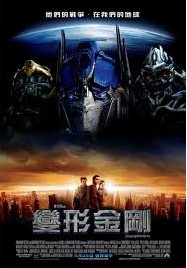 Giant robots from space battle it out19) over the course of this movie and its sequel, causing quite a bit of damage along the way. They’re so big, in fact, that just walking around causes the ground to shake! But when these robots are done mixing it up20), they snap21) together and fold their way down to smaller sizes and more manageable weights.
Giant robots from space battle it out19) over the course of this movie and its sequel, causing quite a bit of damage along the way. They’re so big, in fact, that just walking around causes the ground to shake! But when these robots are done mixing it up20), they snap21) together and fold their way down to smaller sizes and more manageable weights.
So what happens to their mass? A fundamental rule in the universe is that mass cannot be destroyed, so making something smaller doesn’t mean it will be lighter in weight! Any Transformer keeping its mass will therefore become very dense: A 100-foot-tall robot compacting down to a 10-foot car would plunge right through the road and into Earth’s crust.
That would be amusing to watch but would make endless sequels unlikely.
贯穿本片及其续集始终的是来自太空的巨型机器人之间鱼死网破的打斗,一路下来造成的破坏颇为惨重。事实上,它们大得惊人,光是四处走动一下就会引起地动山摇!但是,每当激战完毕,这些巨型机器人就以迅雷不及掩耳之势汇聚一处,将身体折叠起来,体积变得更小,重量也变得更适宜行动。
那么,原来的大块头哪儿去了呢?宇宙中的一条基本法则是物质不灭定律,因此,使某种物体体积变小并不意味着可以减轻它的重量!任何变形金刚要保持质量不变,密度都要大大增加:一个100英尺高的机器人缩成一辆10英尺长的汽车后,将会把道路压塌,陷入地壳。
这样的场面看起来应该会很有意思,不过如此一来,没完没了的续集恐怕就拍不下去了。
BadScience: Mission to Mars《火星任务》
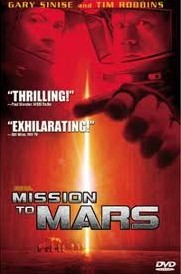 An astronaut in deep space is too far from his ship, and his air is running out. To prevent his shipmates from trying to rescue him and dooming themselves before they reach the Red Planet22), he opens up his spacesuit helmet. He instantly freezes!
An astronaut in deep space is too far from his ship, and his air is running out. To prevent his shipmates from trying to rescue him and dooming themselves before they reach the Red Planet22), he opens up his spacesuit helmet. He instantly freezes!
Yeah, well, in reality, not so much. Human bodies store a lot of heat, and in the vacuum of space the only way to dump that heat is to let it radiate away. (On Earth, cold air could conduct the heat away more rapidly, but we’re in space here.) That would take hours.
The real problem with space exposure is the air rushing out of every orifice23) of your body, causing massive tissue damage and giving you anoxia24). So you wouldn’t freeze; you’d suffocate25). And you certainly wouldn’t explode: Humans aren’t balloons.
Still, no matter what, you’re dead. Best to keep that spacesuit helmet closed.
一名深入外太空的宇航员远离了他的飞船,而他随身携带的氧气即将耗尽。为了阻止同伴因试图营救自己而在抵达火星之前命归西天,他打开了自己的宇航服面罩,迅即被冻僵!
嗯,好吧,实际上,没那么离谱。人体内储存着大量的热量,而在真空环境下,消耗掉这些热量的唯一途径就是让它慢慢地散发(在地球上,冷空气可以将人体的热量迅速地传导出去,但这是在太空)。这可是个费时的事儿。
把身体暴露在太空中的真正问题在于,空气会从你身体的每一个毛孔迅速流走,造成大面积组织损伤,并导致缺氧。因此,你不会被冻死;你会因窒息而死。当然,你是不会爆炸的:人又不是气球。
不管怎么说吧,你都是死路一条。所以,你最好还是把宇航服的面罩给扣严实了!
BadScience: Armageddon
《绝世天劫》
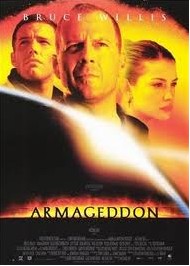 This 1998 blockbuster26) was so exquisitely awful that it’s hard to pick a single instance of bad science in it, since the movie is essentially 99.44 percent steaming garbage.
This 1998 blockbuster26) was so exquisitely awful that it’s hard to pick a single instance of bad science in it, since the movie is essentially 99.44 percent steaming garbage.
The plot is that a Texas-size asteroid is spotted 18 days before it hits Earth. NASA sends a team of wisecracking27) oil-rig workers to plant a bomb that will split it in half so that the two separating chunks will miss Earth, save the day, and allow the boy to get the girl.
But first of all, there is no asteroid that big. Second, if there were, it would be bright enough for Galileo to have seen it. Third, it would take decades for it to get from the asteroid belt28) to Earth. Fourth, oil-rig workers? Fifth, the bomb used to split the asteroid would need to explode with the force of a hundred billion one-megaton29) bombs, millions of times the total yield30) of all nuclear weapons ever detonated31). I, for one, am glad no such bomb exists.
I just wish the movie had bombed32) as well. In the United States it was the second highest-grossing movie of 1998.
这部在1998年红极一时的影片简直糟糕至极,以至于要从中单挑出一个不讲科学的例子都很难,因为它基本上就是一个彻头彻尾的垃圾。
影片的主要情节是说一颗得克萨斯州大小的小行星即将撞击地球,在距离撞击之日仅有18天时,人们发现了这颗行星。于是,美国国家航空航天局派出一组妙语连珠的石油钻井工人去安装炸弹(编者注:根据影片所述,石油钻井工人要在行星上钻洞直至其中心,然后在其中心安装炸弹)。这颗炸弹将把小行星炸成两半,这样两块分离的星体就不会撞上地球,世界将因此转危为安,影片中的帅小伙也就顺利抱得美人归。
但是,首先一点,根本就没那么大的小行星。其次,如果有,那它得多亮啊,伽利略肯定早就注意到它了。第三,它从小行星带到地球要花数十年的时间。第四,石油钻井工人就能把这事搞定?第五,炸弹要炸开小行星所需的爆炸力相当于引爆一千亿颗百万吨级的炸弹,这比所有引爆过的核武器所产生的总当量还要强好几百万倍。就个人而言,我很高兴这样的炸弹不存在。
我倒真希望这部影片也“爆炸”了得了(编者注:此处一语双关,既承接上文表示“炸弹”,也有“惨败”之意),可在美国1998年上映的影片中,这部电影的票房收入居然排名第二。
GoodScience:2001: A Space Odyssey
《2001太空漫游》
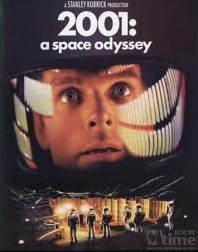 The thing about space is that it’s big. Really big. You might consider this to be its defining characteristic. Even our fastest rockets are agonizingly33) slow when faced with the gulf of interplanetary space.
The thing about space is that it’s big. Really big. You might consider this to be its defining characteristic. Even our fastest rockets are agonizingly33) slow when faced with the gulf of interplanetary space.
Most movies get around34) that by using warp drive35), hyperspace, stargates, or whatever. But 2001 got this right—not surprisingly, since it was penned by the great science fiction writer Arthur C. Clarke. In the movie, the trip to Jupiter takes years. Some of the crew are in suspended animation36) during the journey to save on resources. A spinning centrifuge37) provides artificial gravity for the astronauts who man the ship.
And everything happens very slowly, which, to be honest, makes for something of a dull movie, but quite a realistic one. The slo-mo38) of bodies moving in zero-g is also eerily depicted. In fact, most scientists consider 2001 to be the most scientifically accurate science fiction movie ever made.
太空最重要的特点就是大,真的很大。你用这个特点来定义什么叫太空一点都不为过。面对浩瀚太空中行星间巨大的间隔距离,即便是我们最快的火箭都显得慢得要死。
为了解决这个问题,大多数电影采用了曲速引擎、超空间跃迁、星际之门或其他诸如此类的传送手法。但影片《2001》在这一点上拿捏得很到位——这并不奇怪,因为这部影片出自杰出的科幻小说家阿瑟·C·克拉克之手。在影片中,前往木星的行程耗费了数年时间。为了节约资源,一些成员在旅途中处于休眠状态。一台不停旋转的离心机为操控飞船的宇航员提供人工重力。
一切都进行得十分缓慢。老实说,影片也确实因此显得有点沉闷,但却相当真实。失重状态下身体移动的慢动作虽然看起来别扭,但却得到了充分展现。实际上,大多数科学家都认为,《2001》是自打有科幻电影以来最对得起“科学”这两个字的影片。
GoodScience: Star Trek《星际迷航》
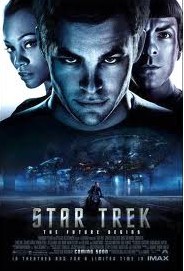 In the opening scene of 2009’s Star Trek movie reboot, the Federation starship USS Kelvin is under attack by the Romulans. We hear explosions, bulkheads are torn apart, there are screams … and then a torpedo39) rips open40) the hull and a crew member is blown out into space. The camera follows her as she tumbles41) out, and when we pass through the hull breach42) into space there is sudden silence.
In the opening scene of 2009’s Star Trek movie reboot, the Federation starship USS Kelvin is under attack by the Romulans. We hear explosions, bulkheads are torn apart, there are screams … and then a torpedo39) rips open40) the hull and a crew member is blown out into space. The camera follows her as she tumbles41) out, and when we pass through the hull breach42) into space there is sudden silence.
Hooray! I mean, it’s too bad about the crew member, but it is rare indeed for a movie to show silence in space. And in the case of Trek, scientific accuracy is used for good dramatic effect, as the sudden silence during the battle is unnerving.
2009年,《星际迷航》再次上映。在影片的开场,联合星舰“开尔文号”遭到了罗穆兰人的袭击。在阵阵爆炸声中,船舱壁被炸成碎片,尖叫声此起彼伏……随后,一颗鱼雷炸开了船体,一名船员被甩进了太空。此时,镜头紧紧跟随她翻滚而出的场景。当我们跟随镜头穿过船体被炸开的缺口进入太空时,映入眼帘的是一片死寂。
酷毙了!我是说,对这名船员来说,这实在是糟糕透顶;但对于一部电影而言,能表现出太空中的死寂实属难得。而且就《星际迷航》而言,对科学知识的准确运用也赋予了影片极佳的戏剧效果,正如在一场战斗突然出现的沉寂,才最让人感到恐惧。
GoodScience: Destination Moon《奔向月球》
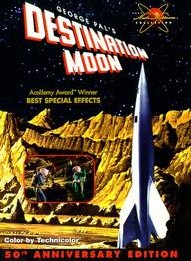 Like 2001, which came out 18 years later, Destination Moon is an accurate depiction of space travel—at least accurate for its time. While other 1950s movies had their rockets zooming to Venus or Mars without a care for time elapsed, fuel, or other matters of basic physics, the fundamental science of space travel is critical to this movie’s plot.
Like 2001, which came out 18 years later, Destination Moon is an accurate depiction of space travel—at least accurate for its time. While other 1950s movies had their rockets zooming to Venus or Mars without a care for time elapsed, fuel, or other matters of basic physics, the fundamental science of space travel is critical to this movie’s plot.
When the rocket lands on our nearest astronomical neighbor, the astronauts realize they don’t have enough fuel for the trip home. They try to lighten their load but conclude that they have to leave one person behind. Other finer points of space travel are there as well: the depiction of acceleration, the need for air locks when entering and exiting the ship, and more. The rocket uses a nuclear engine, a technology that was under serious investigation for a long time.
Interestingly, the movie’s premise is that private industry would build the first rockets to the moon with the government leasing them for use. That’s not too far off from NASA’s current plans. While it’s not the most riveting movie, Destination Moon was a big departure from the giant insect movies and tales of alien rocket ships that followed it for years. And again, like 2001, it had a towering science fiction writer as its adviser: Robert Heinlein, one of the fathers of modern sci-fi.
与18年后上映的《2001》一样,影片《奔向月球》对太空旅行进行了准确的描绘——至少在它所处的那个时代是准确的。20世纪50年代,当其他影片中的火箭都呼啸着飞速奔向金星或者火星,而根本不考虑航行时间、燃料或其他物理学的基本问题时,本片在情节上却十分重视太空旅行所涉及的基本科学原则。
当火箭降落在那个离我们最近的天体上时,宇航员们意识到他们没有足够的燃料返程了。他们试图减轻负载,但最终的结论是有一个人不得不留下来。影片中关于太空旅行的可取之处还有不少,比如对加速度的描写、进出飞船时需要通过空气密封舱等等。火箭采用的则是人们长期以来一直认真研究的核动力引擎技术。
有意思的是,本片假设第一批登月火箭由私营企业建造,由政府租用。而这差不多就是美国国家航空航天局当前的计划。虽然《奔向月球》并不是最精彩的影片,但相比其后数年间那些描写巨型昆虫和讲述外星火箭船的电影,它却是独具特色的。而同《2001》一样,该片的顾问是赫赫有名的科幻小说作家、现代科幻小说的开山鼻祖之一 ——罗伯特·海因莱恩。
GoodScience: Contact《超时空接触》
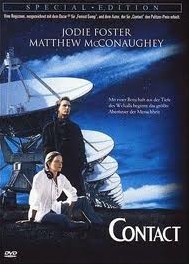 It is impossible to determine just how much science misinformation audiences retain, but it’s safe to say the minuscule2) amount of good science in the movies is entirely outgunned3). After combing through a vast library of science fiction flicks4) both sublime and ridiculous, your intrepid5) Bad Astronomer6) sat down to explain the best and worst of movie science. So grab some popcorn, relax, and be glad that when the lights go back up, the real universe will still be out there for us to enjoy.
It is impossible to determine just how much science misinformation audiences retain, but it’s safe to say the minuscule2) amount of good science in the movies is entirely outgunned3). After combing through a vast library of science fiction flicks4) both sublime and ridiculous, your intrepid5) Bad Astronomer6) sat down to explain the best and worst of movie science. So grab some popcorn, relax, and be glad that when the lights go back up, the real universe will still be out there for us to enjoy.
我们无法确定电影到底给观众灌输了多少错误的科学信息,但可以肯定的是,就算有那么一丁点真正的科学信息包含其中,也常常被大量的错误信息淹没得无影无踪。现在,在对鱼龙混杂的科幻电影大世界进行了梳理分析之后,我,无畏的“蹩脚天文学家”先生,要坐下来好好盘点一下这些电影,看看其中哪些是最讲科学的,哪些又是最不讲科学的。所以,请抓点爆米花,放松一下,待到曲终人散之时,你们将很庆幸那个真实的宇宙依然存在,而我们依然乐居其中。
In this movie, a signal from deep space is discovered, and when decoded it is found to include blueprints for a machine. That machine, when constructed, creates an artificial wormhole that allows Jodie
Foster43)’s character to travel to the center of our galaxy and talk to advanced aliens—who tell her that they didn’t build the wormhole tunnels; an ancient race did.
Given that Carl Sagan44) helped to write the screenplay, it’s no surprise that it is well grounded in real ideas. The galaxy is old, far older than Earth by 8 or 9 billion years, so if there are alien civilizations out there, it’s likely they are millions or even billions of years ahead of us. Look how far we’ve gotten in just a few millennia! Any intelligent aliens we meet could be so far advanced we might have a hard time even recognizing them as being life-forms at all.
And the traveling through wormholes? While that’s all theoretical, it was based on actual physics done by Albert Einstein and his colleague Nathan Rosen45). Along with 2001, Contact is considered one of the most scientifically accurate science fiction movies ever made.
在这部影片中,人们收到了来自外太空的信号,破译后发现信号中包含的是一台机器的设计蓝图。这台机器在建成后制造了一个人工虫洞,朱迪·福斯特饰演的人物就是通过这一虫洞来到了银河系的中心,与外星高等生物对话——这些外星生物告诉她,建造虫洞通道的并不是他们,而是一个古老的族类。
鉴于此部电影的剧本是在卡尔·萨根的协助下完成的,影片能立足于真实的科学理念也就不足为奇了。银河系很古老,比地球要早形成80或90亿年,所以,假如那里真有外星文明,它们很可能要领先我们数百万甚至数十亿年之久。试想一下我们在这区区几千年里所发生的变化吧!我们遇见的任何外星人都可能极其先进,这可能会导致我们压根就难以辨认出它们是一种生命形式。
那么,穿过虫洞的旅行又靠不靠谱呢?虽然这纯属假设,但它依据的却是阿尔伯特·爱因斯坦及其同事内森·罗森实打实的物理学研究成果。与《2001》一样,《超时空接触》也被认为是有史以来最讲科学的科幻电影之一。
1. Phil Plait:菲尔·普莱特,美国著名的天文学家、作家和讲师。他曾为哈勃空间望远镜工作十年,而且从事过天文学教学工作。菲尔还创建了个人博客网站“Bad Astronomy”,博文以杂文为主,嬉笑怒骂中体现了他的睿智和对科学的理解。“Bad Astronomer”也因此成为菲尔的昵称。
2. minuscule [mI5nQskju:l] adj. 极小的
3. outgun [7aut5^Qn] vt. 压倒或击败
4. flick [flIk] n.〈俚〉电影
5. intrepid [In5trepId] adj. 无畏的
6. Bad Astronomer:请参见注释1
7. magnetosphere [mA^5ni:tEusfIE] n. 磁层
8. subatomic particle:亚原子粒子;亚原子微粒
9. Golden Gate Bridge:金门大桥,世界十大名桥之一,被誉为近代桥梁工程的奇迹,屹立于美国加利福尼亚州1996米宽的金门海峡上,是旧金山的象征。
10. feeble [5fi:bl] adj. 微弱的,薄弱的
11. strip off:剥夺,夺去
12. Geonosis:吉奥诺西斯星球,《星球大战》系列电影中的虚构星球,带有土星般美丽光环的一颗行星。
13. seismic [5saIzmIk] adj. [地] 地震的
14. charge [tFB:dV] n. (一定量的)炸药
15. George Lucas:乔治·卢卡斯(1944~),美国著名电影导演、制片人和编剧,代表作为著名的《星球大战》和《夺宝奇兵》三部曲。
16. gambit [5^AmbIt] n. 策略
17. that said:然而;话虽如此
18. acoustically [E5ku:stIk(E)lI] adv. 听觉上,声学上
19. battle it out:决一雌雄,决一死战
20. mix it up:〈美口〉激战,大打出手
21. snap [snAp] vi. 敏捷地动作,迅速地行动
22. Red Planet:〈口〉火星
23. orifice [5CrIfIs] n. 孔,口
24. anoxia [A5nCksIE] n. 缺氧
25. suffocate [5sQfEkeIt] vi. 被闷死,窒息
26. blockbuster [5blCk7bQstE] n. 一鸣惊人者
27. wisecrack [5waIzkrAk] vi. 说俏皮话,说妙语
28. asteroid belt:小行星带,太阳系内介于火星和木星轨道之间的小行星密集区域
29. megaton [5me^E7tQn] n. 百万吨级(原子武器爆炸力计算单位)
30. yield [ji:ld] n. 当量(由爆炸、尤其是核爆炸所释放出的能量)
31. detonate [5detEneIt] v. 引爆
32. bomb [bCm] vt.〈美口〉大败,惨败
33. agonizingly [5A^EnaIzINlI] adv. 使人烦恼地,苦闷地
34. get around:克服(困难、障碍)等
35. warp drive:曲速引擎,一种超光速推进装置
36. suspended animation:(因窒息造成的)生活暂停,假死,休眠状态
37. centrifuge [5sentrIfju:dV] n. 离心机
38. slo-mo:(=slow motion)慢动作
39. torpedo [tC:5pi:dEu] n. 鱼雷
40. rip open:撕开
41. tumble [5tQmbl] vi. 打滚,翻滚
42. breach [bri:tF] n. 裂口,(尤指炮火轰开的)缺口
43. Jodie Foster:朱迪·福斯特(1962~),美国著名演员,曾荣获第61届和第64届奥斯卡最佳女演员奖。
44. Carl Sagan:卡尔·萨根(1934~1996),美国康奈尔大学行星研究中心主任,大卫·邓肯天文和太空科学研究会教授,加州理工学院喷气推进实验室出色的科学家
45. Nathan Rosen:内森·罗森(1909~1995),美国物理学者,以其对氢分子结构的研究成果而闻名于世。
